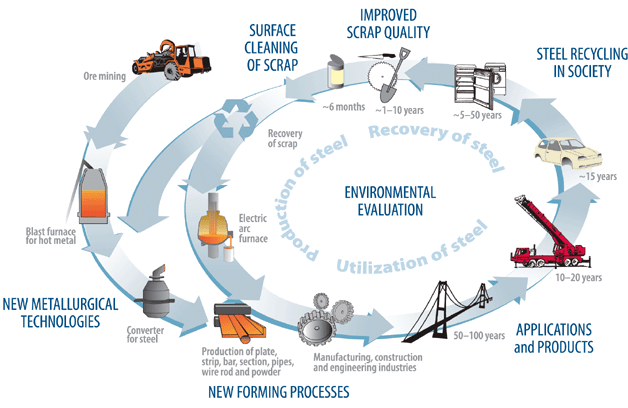
Industrial production of steel began during the second half of the 19th century and quickly became a driving force in the Industrial Revolution. Whilst production methods have changed significantly since those early days, modern steel manufacture is still based on the same principles used in the Bessemer process all those decades ago.
Today, global steel production stands at roughly 1.6 billion metric tons of which two thirds is produced by the basic oxygen steelmaking (BOS) process. The rest is almost entirely produced in electric arc furnaces (EAF). Both processes will be discussed later in the article.
China produces roughly half of the world’s steel, followed by the EU, which produces around 10%. Japan produces around 7% of the world’s steel whilst the US and India each produce roughly 5%. Once the centre of global steel production, the UK now sits in 18th place in the world rankings producing some 12 million tons every year; less than 1% of the global total.

The life cycle of steel is an interesting one, made exceedingly so as the material is completely recyclable. This means that, once produced, steel can travel around the cycle almost infinitely without degrading in quality or strength on each recycle or reuse.
Extraction
Steel begins its life as iron ore, extracted in vast quantities from mines in China, Australia, Brazil and India. Other countries, including Russia and Ukraine also mine iron ore in great quantities, with global total extraction estimated to be somewhere around 2.8 billion metric tons per year.
The leading producer of iron ore, China, is also the largest consumer; despite producing some 1.3 billion tons of crude ore it still imports around 50% of the seaborne trade.
Mining the ore is a low margin game as the value of iron is much lower than the base metals. This, coupled with the fact that it is extremely capital intensive, means it is limited to a handful of global players.
To form useful metallic iron, the ore must be smelted in a blast furnace to remove the oxygen from the iron oxides that form iron ore. The iron ore is mixed with a coke before being sent to the blast furnace, where it is burnt in an oxygen deficient environment to form carbon monoxide and iron.
The iron is impure, however, and before alloying it with carbon to produce steel the impurities from the blast furnace must be removed. The molten iron is mixed with scrap iron and blown with oxygen to further remove carbon particles. The carbon monoxide can be cleaned and used as fuel.
Production
There are two major forms of commercial steel production in the world today. The most popular is basic oxygen steelmaking, which uses the molten pig-iron tapped from the blast furnace and recycled steel to lower the carbon content of the pig-iron to produce useful steel. Other bases such as limestone are added to encourage the removal of impurities.
Electric arc furnace steelmaking uses predominantly recycled steel as the main input as well as electrical energy to melt down the solid scrap.
Manufacturing
Steel is then cast and either manufactured on site or shipped in sheets or ingots to manufacturing plants across the world. The steel is then further processed through various manufacturing methodologies such as forging, extrusion and forming. Final machining, heat treatment and cleaning takes place before finished products are shipped to distributors and retailers.
Often steel components are used inside larger products, for example in construction or automotive industries.
Use
A search for ‘RSJ London’ offers just one example of how steel products are used across the UK and indeed the world. From I-beams in Essex to automobiles in Aberdeen, steel forms a central pillar in any country’s economy. The UK demand for steel was an estimated 11 million tonnes in 2014, reflecting the growing economy and resilient construction industry.
Other uses of steel include ship building, infrastructure projects such as roads and bridges, consumer products and domestic appliances.
Recycling
Finally, when steel products reach their end of life they are recycled back into the cycle. Steel is 100% recyclable, making it one of the greenest materials on the planet. Recycled scrap is used in both of the major steel producing processes, making it the most recycled material in the world. Its estimated almost 90% of all steel produced is recycled!







